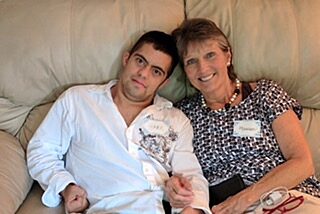A good night’s rest

For 21 years, Mark Scian never enjoyed a deep night’s sleep.
His restless nights began to infringe on his personality and performance at school that resulted in a six-month hiatus from his studies. Mark, 21, who has Down syndrome, or DS, was unaware of his underlying condition until his parents, Maureen and Mike Scian, attended a conference for adults with DS three summers ago. A speaker discussed the prevalence in people with DS and sleep apnea, a disorder where breathing is paused during sleep because of an obstruction to the airway. As a result, people with sleep apnea can develop hypertension, agitation and damage to pulmonary arteries. Those with DS are often diagnosed with sleep apnea because of their unique anatomical build, which includes small airways, large tonsils and low muscle tone.
After returning from the conference, the Scians enrolled Mark in a sleep study at the UF Health Sleep Center to assess his oxygenation and breathing patterns. Mark’s results showed that he had an apnea-hyponea index, or AHI, of 56, which meant that, on average, he ceased breathing 56 times within an hour. Anything greater than 30 AHI is considered to be severe sleep apnea. Mark was immediately placed on a commonly used device for patients with sleep apnea known as continuous positive airway pressure, or CPAP. For three months, Mark wore a CPAP facemask before bed but he removed it unknowingly during sleep. Mary Wagner, M.D., Mark’s pulmonologist at the UF Health Sleep Center, referred him to John Harwick, M.D., an otolaryngologist at UF Health ENT and Allergy – Hampton Oaks, to discuss an alternative treatment.
Harwick chose to try Inspire Therapy®, an FDA-approved stimulation implant device that is the first of its kind to help patients suffering from moderate to severe obstructive sleep apnea. The treatment is ideal for patients like Mark who cannot tolerate a CPAP mask. However, not all patients with sleep apnea are eligible candidates for this treatment with one of the main reasons being a body mass index over 32. After undergoing a bronchoscopy assessment, an airway examination, by Harwick and a physical assessment, Mark was approved to receive the device.
On Feb. 28, Harwick implanted the three-part device in Mark through three, two-inch-incisions. One in the right upper-chest, one under the arm and another under the neck. All three pieces work in conjunction to stimulate nerve branches in the tongue that keep Mark’s airway open during sleep.
Four weeks after the surgery, Maureen and Mike were taught how to turn on the device and gradually increase the voltage using a small remote-control device. By slowly raising the voltage, Mark would become accustomed to the hypoglossal nerve stimulation while he slept. In mid-May, Mark underwent another sleep study to calibrate the device to the lowest voltage giving him maximum breathing, sleep and oxygenation at night. Miraculously, it lowered his AHI to five, meaning he stopped breathing only five times each hour when his device on. Now, Mark is learning to turn the device on and off himself, and is enjoying his improved quality of life.
“He gets up at 6:30 a.m. He can focus and follow directions better, make his own breakfast and lunch, and pack his own gym bag,” Maureen said.
These are all independent living skills that eluded him when he suffered from severe sleep apnea. Mark will graduate in January of 2018 and looks forward to continued volunteering at a medical clinic in Gainesville.
About the author
